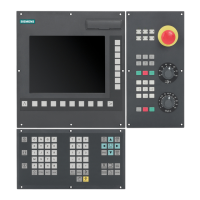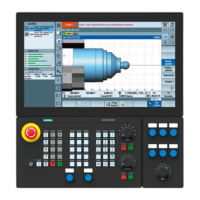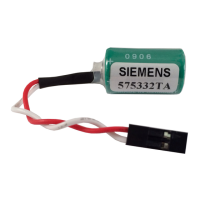Transformations
7.6 Compression of the orientation COMPON (A..., B..., C..., THETA)
Job planning
Programming Manual, 03/2006 Edition, 6FC5398-2BP10-1BA0
7-45
On a machine with 6-axis transformation , the rotation of the tool can be programmed in
addition to the tool orientation.
N... X... Y... Z... A3=... B3=... C3=... THETA=... F=... or
N... X... Y... Z... A2=... B2=... C2=... THETA=... F=...
If the tool orientation is specified via rotary axis positions, e.g., as:
N... X... Y... Z... A=... B=... THETA=... F=...
the compression is interpreted differently, depending on whether large-radius circular
interpolation is performed or not. If large-radius circular interpolation is not performed, the
compressed orientation change is represented by axial polynomials for the rotary axes.
Parameters
The parameter assignments that previously applied to the compressor can also be used for
rotary axis positions.
TRAORI Activate orientation transformation
COMPON Compressor ON
G1 Linear interpolation
X= Y= Z= Linear axis addresses
A= B= C= Rotary axis positions; direct programming
A2= B2= C2= Rotary axis addresses in Euler angles or RPY angles
A3= B3= C3= Rotary axis addresses as direction vectors
THETA Rotation of the orientation vector
F Path feedrate
For more detailed information about programming the THETA=... angle of rotation, please
see "Rotations of the tool orientation (ORIROTA/TR/TT, ORIROTC, THETA)".
Note
Compression only with active large-radius circular interpolation
This is the case when the tool orientation changes in the plane that is defined by the start
and end orientation. The conditions that apply to large-radius circular interpolation must be
set via machine data.
1st machine data: G code for orientation interpolation = FALSE
ORIWKS is active and orientation is programmed as a vector with A3, B3, C3 or A2, B2, C2.
2nd machine data: G code for orientation interpolation = TRUE
ORIVECT or ORIPLANE is active. The tool orientation can be programmed either as a
direction vector or with rotary axis positions. If one of the ORICONxx or ORICURVE G codes
is active or if polynomials are programmed for the orientation angle (PO[PHI] and PO[PSI]),
large-radius circular interpolation is not performed, i.e., blocks of this type are not
compressed.

